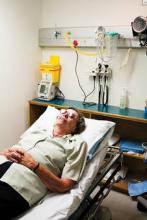New consensus-based guidelines aim to provide a standardized approach to improving the care of patients in geriatric emergency departments.
The Geriatric Emergency Department Guidelines are the result of a 2-year effort by representatives from the American College of Emergency Physicians, the American Geriatrics Society, the Society for Academic Emergency Medicine, and the Emergency Nurses Association. According to 2010 Census data, more than 40 million Americans are now over the age of 65 years. Further, the populations of adults aged 65 years and older and those aged 85 years and older are increasing at rates substantially greater than those of the general population.
"The subsequent increased need for health care for this burgeoning geriatric population represents an unprecedented and overwhelming challenge to the American health care system as a whole and to emergency departments [EDs] specifically," the authors state.
In response to this challenge, geriatric EDs are becoming increasingly common. The new guidelines address the special needs of the geriatric population, and propose methods for ensuring that those needs are met, as "the contemporary emergency medicine management model may not be adequate for geriatric adults."
"Similar programs designed for other age groups (pediatric) or directed toward specific diseases (STEMI [ST segment elevation myocardial infarction], stroke, and trauma) have improved care both in individual EDs and system wide, resulting in better, more cost-effective care and ultimately, better patient outcomes," the guideline writers note.
Among the topics addressed in detail in the guidelines are geriatric ED staffing, equipment, education, policies and procedures, follow-up care, and performance improvement measures.
According to the guidelines, an effective program will:
• Involve hospital site-specific staff and overall local coordination resources.
The guidelines spell out qualifications and responsibilities for the geriatric ED medical director, nurse manager, and staff physicians, nurses, specialists, and ancillary service providers.
• Decrease hospital admissions through effective follow-up and care transition plans.
The guidelines state that clinical patient information should be provided in a format best suited for elder adults and that department leaders should maintain relationships and resources in the community that can be used by patients to facilitate care following discharge.
• Include specialty-specific education and training of a multidisciplinary staff, with assessment for interdisciplinary core competencies.
Education should include "go-live" implementation sessions, as well as community awareness, involvement, and outreach, and regular educational assessment and implementation of site-specific educational needs.
• Assess quality, and implement an effective quality improvement program that involves collection and monitoring of relevant data.
The guidelines provide an explicit geriatric program quality-improvement plan designed to be conducive to staff education and program success.
• Utilize equipment designed for a patient population with specific needs.
For example, effective and comfortable evaluation requires equipment that takes into consideration issues of mobility, incontinence, and behavioral needs while minimizing iatrogenic complications. The physical plant of a geriatric ED should similarly promote safety, comfort, mobility, memory cues, and sensorial perception for elders, according to the guidelines.
• Put in place readily available and easily accessed policies, procedures, and protocols that address the challenges involved in caring for geriatric patients in the ED.
These might address screening for risk of added needs assessment, consultation, and intervention, for example. The guidelines offer specific recommendations and tools for medication management, fall assessment, use of urinary catheters, addressing delirium and dementia, and providing palliative care.
The detailed recommendations provided for each of these topics represent research- and consensus-based best practices from the perspectives of the agencies involved in their development, the authors note.
"Improved attention to the needs of this challenging population has the opportunity to more effectively allocate health care resources, optimize admission and readmission rates, while simultaneously decreasing iatrogenic complications and the resultant increased length-of-stay and decreased reimbursement," they wrote, concluding that with implementation of the recommendations, "hospitals, regardless of size, will positively impact the care of the geriatric emergency patients."


